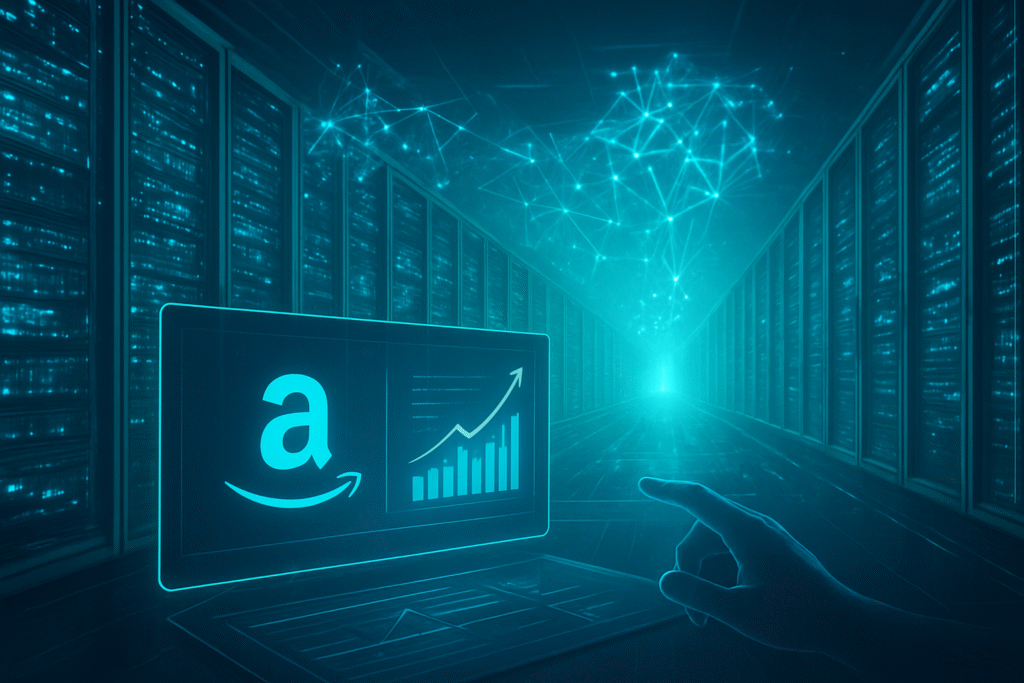
In a bold strategic maneuver that sent ripples across the global tech industry, Amazon.com Inc. (NASDAQ: AMZN) announced on October 28, 2025, its decision to eliminate approximately 14,000 corporate jobs while simultaneously accelerating its massive investments in artificial intelligence. This dual-pronged approach signals a profound reorientation for the e-commerce and cloud computing giant, prioritizing AI-driven efficiency and innovation over a larger human corporate footprint. The move underscores a growing trend within big tech to leverage advanced AI capabilities to streamline operations and unlock new growth vectors, even if it means significant workforce adjustments.
The announcement, coinciding with the current date, highlights a critical juncture where AI is transitioning from a futuristic concept to a direct driver of corporate restructuring. Amazon's decision is poised to redefine its operational ethos, aiming for a "leaner and faster" organization akin to a startup, a vision championed by CEO Andy Jassy. While the immediate impact is a significant reduction in its corporate workforce, the long-term play is a calculated bet on AI as the ultimate engine for future profitability and market dominance.
A Strategic Pivot: AI as the New Corporate Backbone
Amazon's corporate restructuring, impacting an estimated 14,000 employees – roughly 4% of its corporate workforce – is not merely a cost-cutting measure but a strategic pivot towards an AI-first future. The layoffs are broad, affecting diverse departments including Human Resources (People Experience and Technology – PXT), Operations, Devices and Services (including Alexa and Fire TV teams), Prime Video, Amazon Studios, and even segments within its highly profitable Amazon Web Services (AWS) division, particularly in sales, marketing, and operations. These cuts, which began on October 28, 2025, are anticipated to continue into 2026, signaling an ongoing, deep-seated transformation.
Concurrently, Amazon is pouring unprecedented capital into AI, with generative AI at the forefront. CEO Andy Jassy revealed in June 2025 that Amazon had over 1,000 generative AI services and applications either in progress or already launched, emphasizing that this is just the beginning. The company is committed to building more AI agents across all its business units. A significant portion of its projected capital expenditures, expected to exceed $100 billion in 2025, is earmarked for expanding AWS infrastructure specifically for AI. This includes pledging approximately $10 billion apiece for new data center projects in Mississippi, Indiana, Ohio, and North Carolina since early 2024. Furthermore, AWS has committed an additional $100 million to its Generative AI Innovation Center to accelerate the development and deployment of agentic AI systems for its customers.
This strategic shift differs markedly from previous growth cycles, where Amazon's expansion often meant proportionate increases in its human workforce. Today, the narrative is about AI-driven efficiency, automation, and a deliberate reduction of bureaucracy. Jassy’s vision, which includes initiatives like a "Bureaucracy Mailbox" launched in September 2024 to solicit employee feedback on inefficiencies, aims to increase ownership and agility within teams. Initial reactions from analysts have been largely positive, viewing the layoffs as a necessary "deep cleaning" of the corporate workforce and a strong signal of commitment to AI, which is expected to yield significant productivity gains and margin improvements.
Reshaping the AI Landscape: Competitive Implications and Market Dynamics
Amazon's aggressive investment in AI, coupled with its corporate downsizing, has profound implications for the broader AI ecosystem, including rival tech giants, established AI labs, and burgeoning startups. By committing over $100 billion to AI infrastructure in 2025 and developing over a thousand generative AI services, Amazon is not just participating in the AI race; it's actively trying to lead it. This intensifies the competitive pressure on other hyperscalers like Microsoft Corp. (NASDAQ: MSFT), Alphabet Inc. (NASDAQ: GOOGL), and Meta Platforms Inc. (NASDAQ: META), compelling them to either match or exceed Amazon's pace of investment and integration.
Companies that stand to benefit directly from Amazon’s AI surge include hardware providers specializing in AI chips (such as NVIDIA Corporation (NASDAQ: NVDA)), advanced cooling solutions, and specialized data center components. AI startups offering niche solutions for agentic AI systems, model customization, and enterprise-grade AI deployment (like those supported by AWS Bedrock AgentCore and Nova capabilities) will also find a fertile ground for collaboration and integration. Conversely, companies relying on traditional software development models or human-intensive operational processes may face increased disruption as Amazon sets new benchmarks for AI-driven efficiency.
The potential disruption to existing products and services is vast. Amazon's integration of generative AI into Alexa, e-commerce shopping tools, inventory management, demand forecasting, warehouse robotics, and customer service chatbots signifies a comprehensive overhaul of its core offerings. This could set new industry standards for customer experience, supply chain optimization, and operational cost structures, forcing competitors to adapt or risk falling behind. Amazon's market positioning as a leader in both cloud infrastructure (AWS) and AI innovation provides a formidable strategic advantage, enabling it to offer end-to-end AI solutions from foundational models to highly customized applications, thereby capturing a larger share of the burgeoning AI market.
The Broader Significance: AI's Impact on Work and Society
Amazon's strategic shift is a microcosm of a much larger trend sweeping across the global economy: the transformative impact of artificial intelligence on the nature of work and corporate structure. The decision to cut 14,000 corporate jobs while simultaneously accelerating AI spending highlights AI's growing role not just as an augmentative tool but as a direct driver of workforce optimization and, in some cases, displacement. This fits squarely into the broader AI landscape where generative AI and agentic systems are increasingly automating repetitive tasks, enhancing productivity, and necessitating a re-evaluation of human capital requirements.
The impacts on the tech workforce are significant. While new jobs in AI development, engineering, and ethical oversight are emerging, there is an undeniable shift in required skills. Employees in roles susceptible to AI automation face the imperative of reskilling and upskilling to remain relevant in an evolving job market. This situation raises potential concerns regarding economic inequality, the social safety net for displaced workers, and the ethical responsibility of corporations in managing this transition. Amazon's move could serve as a bellwether, prompting other large enterprises to similarly assess their workforce needs in light of advanced AI capabilities.
Comparing this to previous technological milestones, such as the internet revolution or the advent of mobile computing, AI presents an even more profound challenge and opportunity. While past shifts created new industries and job categories, the current wave of AI, particularly generative and agentic AI, possesses the capacity to directly perform cognitive tasks traditionally reserved for humans. This makes Amazon's decision a pivotal moment, illustrating how a major tech player is actively navigating this "tipping point away from human capital to technological infrastructure," as one analyst put it.
The Road Ahead: What to Expect from Amazon's AI Future
Looking ahead, Amazon's aggressive AI strategy suggests several key developments in the near and long term. In the immediate future, we can expect continued integration of AI across all Amazon services, from highly personalized shopping experiences to more efficient warehouse logistics driven by advanced robotics and AI-powered forecasting. The 90-day transition period for affected employees, ending in late January 2026, will be a critical time for internal mobility and external job market adjustments. Further workforce adjustments, particularly in roles deemed automatable by AI, are anticipated into 2026, as indicated by Amazon's HR chief.
On the horizon, the potential applications and use cases are vast. We could see the emergence of even more sophisticated AI agents capable of handling complex customer service inquiries autonomously, highly optimized supply chains that anticipate and respond to disruptions in real-time, and innovative AI-powered tools that redefine how businesses operate on AWS. The company's focus on enterprise-scale AI agent deployment, as evidenced by its AWS Generative AI Innovation Center and new Bedrock capabilities, suggests a future where AI agents become integral to business operations for a wide array of industries.
However, significant challenges remain. Amazon, and the tech industry at large, will need to address the societal implications of AI-driven job displacement, including the need for robust reskilling programs and potentially new models of employment. Ethical deployment of AI, ensuring fairness, transparency, and accountability, will also be paramount. Experts predict a continued "deep cleaning" of corporate workforces across the tech sector, with a greater reliance on AI for operational efficiency becoming the norm. The success of Amazon's bold bet will largely depend on its ability to effectively scale its AI innovations while navigating these complex human and ethical considerations.
A Defining Moment in AI History
Amazon's decision to cut 14,000 corporate jobs while simultaneously pouring billions into artificial intelligence marks a defining moment in the history of AI and corporate strategy. It underscores a clear and unequivocal message: AI is not just a tool for marginal improvements but a fundamental force capable of reshaping entire corporate structures and workforce requirements. The key takeaway is Amazon's unwavering commitment to an AI-first future, driven by the belief that generative AI will unlock unprecedented efficiency and innovation.
This development is significant because it provides a tangible example of how a leading global corporation is actively reallocating resources from human capital to technological infrastructure. It validates the widespread prediction that AI will be a major disruptor of traditional job roles, particularly in corporate functions. As we move forward, the long-term impact will likely include a redefinition of what constitutes a "corporate job," a heightened demand for AI-centric skills, and a continued push for operational leaness across industries.
In the coming weeks and months, the tech world will be watching closely. Key indicators to monitor include Amazon's financial performance (especially its margins), further announcements regarding AI product launches and service integrations, the success of its internal talent transition programs, and how other major tech companies respond to this aggressive strategic shift. Amazon's AI gambit is not just a corporate story; it's a powerful narrative about the evolving relationship between humanity and artificial intelligence in the 21st century.
This content is intended for informational purposes only and represents analysis of current AI developments.
TokenRing AI delivers enterprise-grade solutions for multi-agent AI workflow orchestration, AI-powered development tools, and seamless remote collaboration platforms.
For more information, visit https://www.tokenring.ai/.






